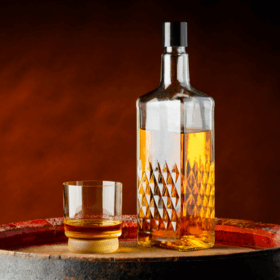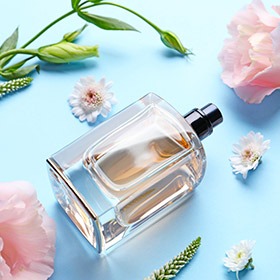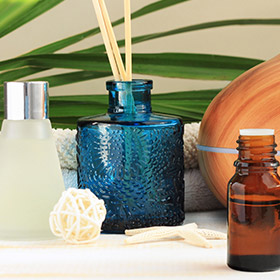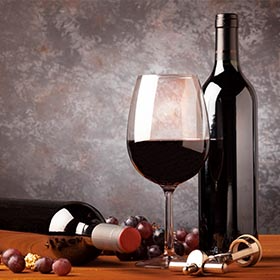Introduction
As a consumer, you may not pay much attention to the color of wine bottles on the shelf. You might only care whether it’s Bordeaux or Burgundy, and whether the vintage is recent or aged. However, for wine producers and distributors, the color of the wine bottle is highly significant. The color of the glass wine bottle often impacts the shelf life, flavor integrity, and aesthetic appeal of the bottled wine. It is not merely an aesthetic choice; it is also a critical factor in determining the wine’s ability to resist external threats—especially light exposure.
With increasing market segmentation, from traditional reds to trendy rosés and sparkling varieties, the demand for tailored packaging solutions has grown. Whether you’re launching a new vintage or expanding distribution globally, understanding the role of bottle color is critical.
As a professional glass wine bottle manufacturer, Roetell offers a comprehensive guide for glass bottle retailers, wholesalers, and the entire wine industry, including distributors who depend on high-quality glass bottles for packaging. This guide explores the scientific principles behind glass color and its impact on wine preservation. Our goal is to help elevate your brand reputation and, ultimately, maximize your profitability. Whether you are sourcing 750ml wine bottles, purchasing bulk mini wine bottles, or planning to resell empty wine bottles, the insights we provide will support informed decision-making, protect your investment, and meet your customers’ expectations.
The Science Behind Wine Degradation and Glass Protection

How Light Affects Wine Quality
Wine is highly sensitive to light, particularly ultraviolet (UV) and visible light. UV (ultraviolet) and visible blue spectrum (around 370-450 nanometers) will make wine spoilage, this is often referred to as ‘light-strike’ or ‘goût de lumière,’ and it is a significant concern for winemakers and distributors. The primary culprits in this process are riboflavin (Vitamin B2) and amino acids, which act as photosensitizers. When exposed to light, riboflavin absorbs energy and transfers it to other molecules, leading to the formation of highly reactive free radicals. These radicals then react with sulfur-containing amino acids, such as methionine, to produce volatile sulfur compounds (VSCs) like dimethyl disulfide (DMDS) and methanethiol. These compounds are responsible for the unpleasant aromas associated with light-struck wine, often described as cooked cabbage, burnt rubber, or wet wool. White and sparkling wines are particularly vulnerable due to their lower tannin content. Research from the Australian Wine Research Institute found that wines exposed to light for even 1–3 days developed significant aroma faults.
Besides aroma degradation, light exposure can also lead to:
Oxidation: Light accelerates the oxidation of phenolic compounds, leading to browning in white wines and a loss of vibrant color in reds.
Discoloration: Pigments in wine can be altered, causing white wines to turn yellowish-brown and red wines to lose their intensity, appearing brick-red or orange.
Flavor Change: The delicate balance of fruit and floral notes can be replaced by harsh, metallic, or stale flavors.
These features further show the importance of color in glass wine packaging.
How Glass Color Reduces Risk
Glass, by its very nature, offers a degree of protection against light. However, the color of the glass significantly dictates its ability to filter out harmful wavelengths. This is where the strategic choice of wine bottle color becomes a critical decision for glass bottles wholesale and glass bottle wholesale buyers.
Different glass colors possess varying UV-blocking performances:
Amber Glass: This color provides the highest level of protection against both UV and visible blue light. Amber glass typically blocks 90–95% of harmful UV radiation, making it the superior choice for wines highly susceptible to light-strike.
Green Glass: The traditional choice for many wines, green glass offers moderate protection. Its effectiveness varies depending on the shade; darker greens (like antique green) provide better protection than lighter greens (like dead leaf green). On average, green glass blocks approximately 30–50% of UV light. While better than clear glass, it still allows a significant portion of damaging light to pass through.
Clear (Flint) Glass: Designed to showcase the wine’s color, clear glass offers minimal protection against light. It allows nearly all wavelengths of light to pass through, blocking less than 10% of UV radiation. While visually appealing for certain wine styles, its use necessitates careful consideration of storage and display conditions to prevent rapid degradation.
This makes color selection not just a visual choice but a performance decision, especially for wines intended for long-term aging or global export. Wine bottle colors contribute to the chemical stability of the beverage throughout its lifecycle. Especially for medium and large red wine brands, choosing the right color glass bottle is particularly important for spreading corporate culture, maintaining customers, and maintaining brand awareness.
Amber Glass Bottles – The Preservation Leader
Amber glass bottles are undoubtedly the best at protecting wine from the harmful effects of light. Their unique dark color is not only beautiful but also practical, effectively blocking all kinds of harmful light, including ultraviolet and visible blue light. For wineries and distributors who value the long-term quality and stability of their products, amber glass bottles must be the best choice.
Its characteristics are as follows:
Iron-sulfur compounds added during the manufacturing process enable it to absorb light of various wavelengths. This excellent performance makes it an ideal choice for wines that are sensitive to light or need to be aged for a long time. The complex phenolic compounds in red wines will undergo adverse changes under light, affecting their color stability and aroma characteristics over time. For aging wines, their value and flavor can be greatly affected by these subtle differences, so it is crucial to maintain their original state. Amber bottles ensure that these subtle evolution processes are not disturbed by external light, thereby preserving the original characteristics and value of the wine.
By minimizing light-induced spoilage, amber glass bottles can reduce the risk of product returns, customer complaints, and related financial losses. For high-value wines, where each bottle represents a significant production and marketing investment, this extra layer of protection is critical. It ensures that the wine reaches the consumer in the state the winemaker intended, reinforcing brand integrity and consumer trust. This is particularly important for wines destined for international markets or that experience a variety of storage conditions during transportation and retail display.

Green Glass Bottles – The Classic, Balanced Choice
Green wine bottles, while not as sun-protective as amber glass bottles, have a combination of moderate UV resistance, aesthetics, and historical significance that make them a favorite for old-school estates or European wine brands.
For centuries, green glass has been the default choice for many of Europe’s iconic wine regions, especially in France (Bordeaux, Burgundy) and Italy. This tradition is deeply rooted in the perception of these wines, and for many consumers, green wine bottles symbolize quality and heritage. Today, this historical origin has evolved into a powerful marketing tool. Many red wines from these regions, and even some white wines, are still bottled in green glass bottles to this day to take advantage of this established visual image. For wholesale wine bottle suppliers, understanding the preferences and historical background of these regions is crucial to meeting market needs. Green wine bottles, while not as UV-resistant as amber glass, are still significantly better than clear glass in terms of sun protection. This makes them a viable option for a variety of wines, including many red and white wines that require a certain degree of sun protection and prefer the aesthetics of green wine bottles to enhance their brand image.
Clear Glass Bottles – Focus on Shelf Appeal
Clear wine bottles, A.K.A flint glass, represent a distinct segment within the wine packaging industry. Unlike their amber or green counterparts, their primary function is not light protection but rather to offer maximum transparency, allowing the consumer to fully appreciate the wine’s color and clarity. However, this visibility comes at the cost of UV protection. For glass bottle wholesale and glass bottle supplier businesses, understanding this trade-off is crucial when advising clients.
Clear wine bottles are best used when:
The product is consumed quickly after purchase.
Ideal for Rosé, Sparkling, or Marketing-Driven Wines
The bottle is stored in dim or controlled environments.
Brands want to highlight color, clarity, and luxury.
For brands that prioritize a modern, minimalist, or visually striking presentation, clear wine bottles are often the preferred choice, even for unusual wine bottles or unique wine bottle designs that aim to stand out on the shelf.
The transparency of clear glass makes it very attractive in marketing, but it also becomes the biggest weakness. Clear glass provides the least protection against harmful light, blocking less than 10% of UV rays. Due to the lack of UV filtering, a wide spectrum of light can penetrate the wine, accelerating oxidation and causing off-flavors and aromas. For companies that want to maintain both light transmittance and the pure taste of the liquid, it is basically impossible.
Other Uncommon Colors: Blue & Black
While not standard in the wine industry, blue and black bottles are gaining popularity in niche markets:
Blue Glass: Evokes modernity and freshness. Often used for boutique white or dessert wines.
Black Glass: Offers complete light protection and a sleek, premium appearance. Ideal for luxury or limited-edition wines.
These unusual wine bottles can be used to target specific demographics or align with bold branding strategies. Blue bottles appeal to younger demographics in Southeast Asia, while black bottles are favored in luxury hospitality chains and high-end gift packaging.
Performance Comparison: Color vs. Protection, Branding, and Logistics
Bottle Color | UV Protection | Brand Messaging & Market Positioning | Visibility | Cost & Availability | Logistics & Supply Chain Considerations |
Amber | ★★★★★ (90–95% UV blockage) | Premium, traditional, aged wines; communicates quality and protection | Low (obscures wine color) | Widely available, cost-effective | Excellent for export or long-term storage; preferred for red or aged wines |
Green | ★★★☆☆ (30–50% UV blockage) | Heritage-rich; classic European style; trusted by traditional consumers | Medium | Common and affordable | Good balance for various wine types; suits broad supply conditions |
Clear | ★☆☆☆☆ (<10% UV blockage) | Modern, fresh, transparent; ideal for rosé, sparkling, and visual appeal | High | Easily sourced, low cost | Needs careful handling and extra packaging for light protection |
Blue | ★★☆☆☆ (Moderate) | Niche, boutique appeal; modern and trendy; differentiates brand | Medium-High | Less common, higher cost | Limited availability; used for standout or specialty packaging |
Black | ★★★★★ (Very high) | Luxury, mystery, high-end positioning; disrupts norms | Very Low | Specialized production; higher lead time | Excellent light protection; ideal for premium SKUs and gifting markets |
Summary Recommendations:
Wineries focused on aging or export should prioritize amber for maximum UV protection.
Heritage brands may opt for green to blend tradition with performance.
Modern wine lines and marketing-driven labels can benefit from clear bottles, but should account for added protection layers.
Boutique or niche brands looking to stand out might consider blue or black, despite higher costs and logistical challenges.
This chart helps buyers balance protection needs, branding goals, and cost-efficiency when choosing glass bottles wholesale.
How to Select the Right Wine Bottle Color for Your Brand
For wine producers or wineries, choosing the ideal wine bottle color is both a challenge and an important decision, requiring a thoughtful assessment of the product, supply chain, and target market. For glass bottle and glass jar retailers, glass bottle and glass jar wholesalers, as well as the entire wine industry and distributors, understanding wine bottle colors and mastering professional knowledge is a major advantage in serving wine bottle customers.
Consider the Wine Type
Red Wines: Generally more robust due to their higher tannin content, red wines can be suitably protected by green glass, which is the traditional choice for many classic reds. However, for premium red wines intended for long-term aging or those with delicate aromatic profiles, amber glass bottles offer superior protection.
White Wines: Highly susceptible to light-strike, white wines benefit significantly from the protection of darker glass. For most white wines, particularly those with complex aromatics or aging potential, green or amber glass is a safer and more prudent choice.
Rosé Wines: Highly susceptible to light-strike, white wines benefit significantly from the protection of darker glass.
Sparkling Wines: Similar to rosés, the visual allure of bubbles is important. However, sparkling wines are also highly sensitive to light. This is why many are bottled in green glass, offering a balance between protection and tradition.
Aged Wines: Amber glass offers better long-term preservation.

Supply Chain Conditions
Local vs. Export: Wines destined for local markets with short, controlled supply chains might be able to tolerate less protective packaging. However, for export markets, where wines endure long transit times and varied storage conditions, the robust protection of amber or dark green glass is highly recommended.
Retail Lighting: Consider the typical retail environment where your wine will be sold. Bright, fluorescent lighting can be particularly damaging. If your wine is likely to sit on a retail shelf for an extended period, a darker bottle is a wise investment in quality preservation.
Warehouse Environments: What are your storage conditions like? Is it bright or dark? Is it humid or dry? Do you have a system in place to control storage and overall conditions? If conditions are uncontrolled and the product is exposed to sunlight, dark-colored bottles are essential.
Market Preferences & Brand Positioning
Finally, your choice of bottle color must align with your brand identity and the expectations of your target market:
Consumer Expectations: In some regions, consumers have strong associations between bottle color and wine style or quality. Understanding these preferences can help you choose a bottle that resonates with your target audience. Like classic European markets, they often prefer green and amber wine bottles. Meanwhile, Asian Markets will prefer elegant and minimalist black packaging for gifting wines.
Brand Positioning: Are you a classic, heritage brand? Or you are a modern, innovative brand? Are you a premium, artisanal brand focused on ultimate quality? Choosing appropriate colors according to the different brand positioning will help maintain the brand image and reflect the corporate culture.
For those seeking empty wine bottles for sale or cheap wine bottles, it’s crucial to remember that the right color is not just a cost consideration but an investment in your product’s future.
Partnering with Roetell Glass for High-Performance Wine Bottles
In the competitive wine industry, packaging plays a critical role in preserving quality, expressing brand identity, and supporting logistics. Roetell Glass, a leading glass bottle supplier and manufacturer, delivers high-performance wine bottle solutions tailored to the global wine supply chain.
Why Partner with Roetell Glass?
Flexible MOQs for both small and large wine brand, MOQ 3000 units
A wide selection of 750ml glass bottles with screw caps (wholesale), amber, blue, green, black and clear wine bottles avalaible
Full customization services for mini wine bottles wholesale, unique shapes, and branded embossing
Rapid lead times with strong international shipping capabilities
Over 30,000 square meters of production facilities and 8 fully equipped modern production lines
Our Value-Added Services
One-stop packaging solution: From concept to delivery, we handle everything—design, production, labeling, closures, and logistics
Professional support: Our team brings deep industry knowledge to help you choose the right glass bottle color, style, and closure based on your wine type, market, and logistics
After-sales service: We provide responsive support to ensure smooth collaboration and long-term satisfaction
Sustainable options: Roetell supports sustainability through lightweight glass, recycled materials, and efficient production, helping brands reduce carbon footprint and shipping costs. From 187ml wine bottles wholesale to unusual wine bottles for premium lines, we offer scalable packaging for every wine category—without compromising quality or budget.
With Roetell’s expert team and streamlined operations, your packaging process becomes more efficient, cost-effective, and brand-aligned. Whether you need unusual wine bottles, mini wine bottles in bulk, or standard glass bottle wholesale packaging, Roetell is your reliable manufacturing partner in the global wine supply chain.
Conclusion
In wine packaging, color is more than a visual element—it’s a functional asset. The right wine bottle color ensures that the product maintains its intended quality from winery to consumer. By understanding the relationship between glass color and wine preservation, brands can make data-driven decisions to elevate both protection and market positioning.
Whether you need small wine bottles bulk, or 187ml wine bottles wholesale, Roetell Glass has the technical expertise and manufacturing scale to support your goals. From high-performance amber glass to eye-catching clear and blue bottles, we provide packaging solutions that preserve quality and enhance brand identity.
Let your wine shine—and stay preserved—with the right bottle from Roetell Glass. Contact us today to explore our full range of glass packaging options.












